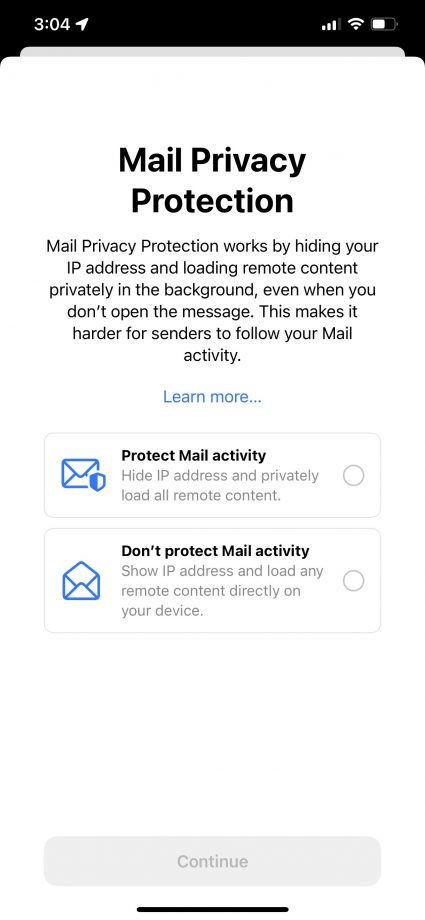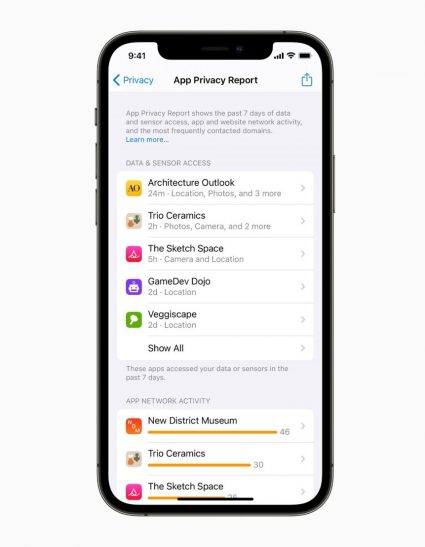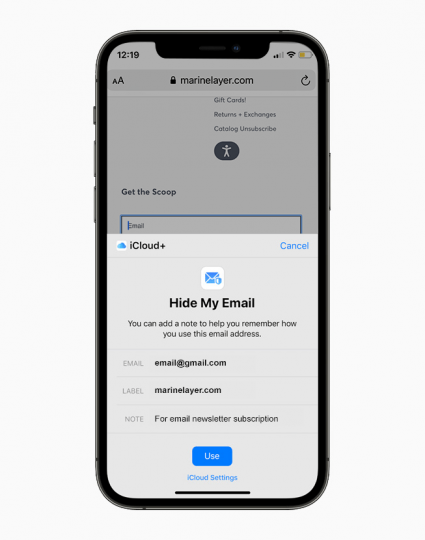During Apple’s annual Worldwide Developer Conference (WWDC) keynote last week, the tech titan unveiled a handful of privacy-focused updates that will encompass its operating systems, including the upcoming iOS 15. (As a general note, iOS 15 is expected to be available as a beta in July, before being released to the public this fall. The days of extended timelines around iOS 14.5 are over: this new update will likely be here before we know it.)
One of the biggest headlines is the introduction of iCloud+, a subscription service designed to provide users with a more private online browsing experience, which will layer on top of Apple’s tightened restrictions on how apps access data.
To no one’s surprise, the new privacy features—in addition to the App Tracking Transparency framework that rolled out earlier this year—are expected to further complicate marketers’ ability to track and target customers, while reinforcing Apple’s place as a key player in the future of consumer data privacy.
So, let’s take a look at the biggest updates Apple announced, and what our braintrust of marketing experts are saying about them.
Mail Privacy Protection

Ready or not, Mail Privacy Protection is coming to iOS 15. This is a new tab in Apple’s native Mail app that’s meant to do exactly what the name suggests: let users decide what personal information the program shares. Within the app, users can choose to hide specific data, such as their IP address or when they’ve opened an email, from email senders (many of whom are marketers).
As Apple executives explained during the keynote, this is to ensure that a user’s IP address “can’t be linked to other online activity or used to determine their location.” These changes will apply to the Mail app across all Apple devices, including the iPad, iPhone, and the Mac.
What does this mean for marketers?
The new Mail Privacy Protection feature will almost certainly impede marketers’ ability to gather information about email open rates. If you’re using the “last-opened” date for segmentation or targeting purposes, that cohort will likely be rendered useless for Apple Mail users. It may also affect subject line testing based on open rates due to a “phantom opener” issue that will likely inflate marketers’ data sets.
While open rates are commonly seen as a vanity metric when it comes to measuring email performance, they are still considered essential when it comes to maintaining good list health and deliverability.
This begs the question: how should you more accurately measure the success of your email campaigns? Here’s what our email experts recommend:
- Look beyond opens for effective segmentation and re-engagement:
- Designate other high-quality data points that you can use to identify, segment, and re-engage customers. Look at a combination of factors like signup rates, click-through data, purchase dates, and any other reliable information you may have in your database that determines what your business considers an active user. And remember that open rate data will still be valid and valuable for users who are not using Apple’s Mail app, as well as for Apple users who don’t opt out of tracking.
- Prepare early to ensure your email deliverability is on track:
- An effective deliverability strategy means tracking activity at top-level ISPs and making decisions about how to segment based on that data. The good news is that you’ll likely still have some of that information, so you can prepare for the upcoming changes by setting benchmarks ahead of time. For example, by determining how many of your users today are Gmail users who also use Apple Mail, you can pinpoint the level of dropoff you expect to see in your Gmail open rates once these changes are implemented and adjust your expectations accordingly. You should use the coming weeks wisely to determine what those audiences look like so that you can level-set for the future.
- Identify which features will be affected by a lack of an IP address:
- You’ll need to reconsider how you’re using features like send-time optimization and geo-location to determine which elements of your email program are successful. To obtain a user’s geolocation, for example, you’ll need to prompt them at signup to share their location. You’ll need to clearly communicate what they’ll receive in return, such as a designated home store location for localized events and information or certain offers that are only available in their area.
- Start tracking click-through rate over opens and keep growing your list:
- As we noted before, open rates aren’t going away completely: you’ll still have access to that information for some segments. But you should also account for other metrics like click-through rates when considering the efficacy of a subject line.
- One kind of A/B test that may no longer be viable is the 10-10-80 method, which is when you test with two small groups and send a winning subject line to the larger group. Because your pool of users with a valid open rate will likely shrink, reaching statistical significance for this kind of test may be much more difficult. Running a standard 50/50 split will likely yield more relevant results.
- The larger your email list, the more you’ll be able to absorb and handle these changes, so don’t discount the importance of prioritizing a strategic approach to list growth.
App privacy reports

When Privacy Nutrition Labels were introduced with iOS 14, developers had to disclose what data they collect about consumers, and how it’s used. With App Tracking Transparency, they had to ask permission before they could collect data. Now, with App Privacy Reports, Apple is peeling back the layers even more in an effort to hold app developers accountable to consumers.
These reports provide users with detailed information about how various apps are collecting and using their personal data, as well as how much of their data is being shared with third parties for tracking purposes.
They also indicate how frequently certain apps access users’ location, photos, camera, microphone, and contacts over a period of seven days. Think of it as a kind of privacy “report card” for all of a device’s applications. It will be added as a software update to iOS 15, so it probably won’t be available at launch.
What does this mean for marketers?
While it’s not entirely clear how many Apple users will actually take advantage of the App Privacy Report, which will be an opt-in feature within their device settings, your brand should be clearly communicating why you need the permissions you’ve requested and how they’ll provide value to each individual user.
Think of this as an opportunity for your brand to get more transparent about the technologies you use and the purpose they serve, rather than cause for alarm. It’s best to get in front of the situation by doing more to educate your users about how you’re collecting and using their data sooner, rather than later. That way, there aren’t any painful surprises later down the road.
SKAdNetwork update
Apple is also making a tweak to SKAdNetwork in iOS 15 that will strip the big ad platforms (Facebook, Google, and Twitter) of their status as self-attributing networks.
To give you a brief refresher, SKAdNetwork is Apple’s privacy-friendly attribution API for mobile app downloads, and the only solution in the Apple ecosystem for devices that haven’t opted in to the Identifier for Advertisers (IDFA).
It attributes mobile app installs to an ad campaign, which is critical in determining campaign success and fighting fraud. However, unlike the IDFA, it doesn’t reveal any user- or device-level data. Digital ad giants were essentially forced to add SKAdNetwork support when Apple’s AppTrackingTransparency (ATT) framework went into effect in late April.
What does this mean for marketers?
Starting with the next version of iOS, slated for release sometime this fall, marketers will soon be able to get data on postbacks, or mobile app install validations, directly from Apple’s SKAdNetwork rather than having to go through a registered ad network.
While SKAdNetwork hasn’t emerged as a useful alternative to the IDFA due to the limited amount of accessible information for marketers so far, the upcoming iOS 15 changes are a much-needed aid for those looking to optimize their measurement and attribution as much as possible in the privacy-centric world Apple is building.
The new iCloud+
Apple is introducing a new subscription service called iCloud+ which includes a slew of new privacy-focused features, but there are two in particular that marketers need to be aware of:
- iCloud Private Relay
- Hide My Email
Before we dive in, we want to make one thing clear: currently, iCloud accounts for 27% of cloud customers in America, according to new data published by Strategy Analytics. We generally expect only about 10-20% of users to actually make the jump to this premium service (at least when it initially rolls out).
Private Relay
iCloud+ users will be able to utilize a feature called Private Relay, which will allow Apple to redirect web traffic through two separate servers in order to obfuscate a user’s IP address. One will assign the user an anonymous IP address, and the second will forward them to a destination. Private Relay essentially acts as a VPN (virtual private network) that allows for multiple identifiers to be obscured by passing requests through a “trusted third party” which, in this instance, appears to be Cloudflare.
This is a new service built into iCloud+ that will let users browsing on Safari completely encrypt their traffic. Apple says this setting ensures that “no one between the user and the website they are visiting can access and read” any data sent over Private Relay, not even Apple or the user’s network provider.
What does this mean for marketers?
ISPs and other data brokers who currently sell user insights based on browsing behavior will likely have a much harder time capturing that information from Apple devices, potentially making marketing more difficult for brands who rely on purchased third-party data going forward.
It also increases the need to move to server-side solutions and new measurement methodologies, similar to Facebook’s adoption of Aggregated Event Measurement (AEM), which is modeled off of Apple’s Private Click Measurement, and will allow for the measurement of web events from iOS users by aggregating performance data at the campaign level.
While AEM is not yet fully baked, it will likely be more limited than previous measurement tools by design. For those hoping to use Facebook’s Conversion API as a workaround to send both online and offline events from their server directly to Facebook for cross-platform measurement, Facebook has said that the events will also be processed in accordance with the limits set by AEM. So, no such luck.
With that said, the real impact is on data that’s being collected without users’ consent—after all, Private Relay won’t affect your brand’s ability to capture valuable first-party data throughout different stages of the funnel. Brands that continue to focus on building dynamic two-way communications and community-focused experiences with their customers shouldn’t be significantly affected.
Hide My Email

The second iCloud+ feature, Hide My Email, lets you generate random, duplicative email addresses when you sign up to a newsletter or when you create an account on a website. It works by forwarding emails from a randomly generated address to a user’s personal inbox, so they can still view emails from the sender without giving away their personal email address.
Hide My Email also lets users generate and delete as many random addresses as they need, giving them greater control over who is able to contact them. For those with an iCloud+ subscription, the option to use Hide My Email will be automatically included and available in the Mail app, as well as Safari and iCloud once the software updates roll out later in the year.
What does this mean for marketers?
While it’s still too soon to say how many Apple users will use Hide My Email, it’s likely to have an impact on your email efforts since users may now be able to more effectively turn off your ability to send campaigns to them at will (and do so without notifying you).
The new feature may also have the potential to cause a decline in accuracy of user identification, particularly on platforms like Facebook. “These changes will impact providers that may rely heavily on IP addresses for identification,” notes Sara Stevens, VP of Digital Capabilities at Epsilon. Without access to data like IP addresses, marketers will need to adopt newer, more privacy-centric ways to track user behavior and serve targeted ads. “Marketers should increasingly favor identity resolution providers that focus on privacy-safe, person-level, consented identifiers.”
But developing a strong, permission-based email strategy is still the best route to optimizing performance and developing long-lasting customer relationships built on trust.
If you’re looking to grow your email list with quality contacts (not dummy email addresses), you must obtain explicit consent by being direct and clear at the point of sign-up. When asking people to join your list, be straightforward about what type of content you plan to send. Special offers, promotions, and exclusive content are a great incentive for people to join your list, but if you don’t follow through, you could lose their trust (and business) forever.
Earning your spot in your customers’ inboxes is not a negative: research shows that the average open rate for email campaigns to recipients who have given you explicit permission to email them is around 30-40%, while the average click-through rate is around 20%. On the other hand, email campaigns sent to lists of subscribers without their permission have average open rates of around 2% and click-through rates of around 0.2%.
Your list will be the backbone of the powerful first-party data strategy that will be a key competitive differentiator in a privacy-first world.
Prioritize the customer experience in your email program by leveraging segmentation, personalization, and real-time data to better inform your outreach, and start integrating email into your overarching marketing strategy to make the most of that data.
Don’t run away from data privacy considerations: it’s truly time to make privacy a priority for your business to set your brand up for future success. We’ll keep you updated on the latest in privacy regulations and changes.
Want to explore how a first-class, privacy-first marketing strategy will give your business an edge in the market? Talk to an expert from our team.
Contributing Experts: Jared Smith, Joshua Yelle, Cory Smith







Responses